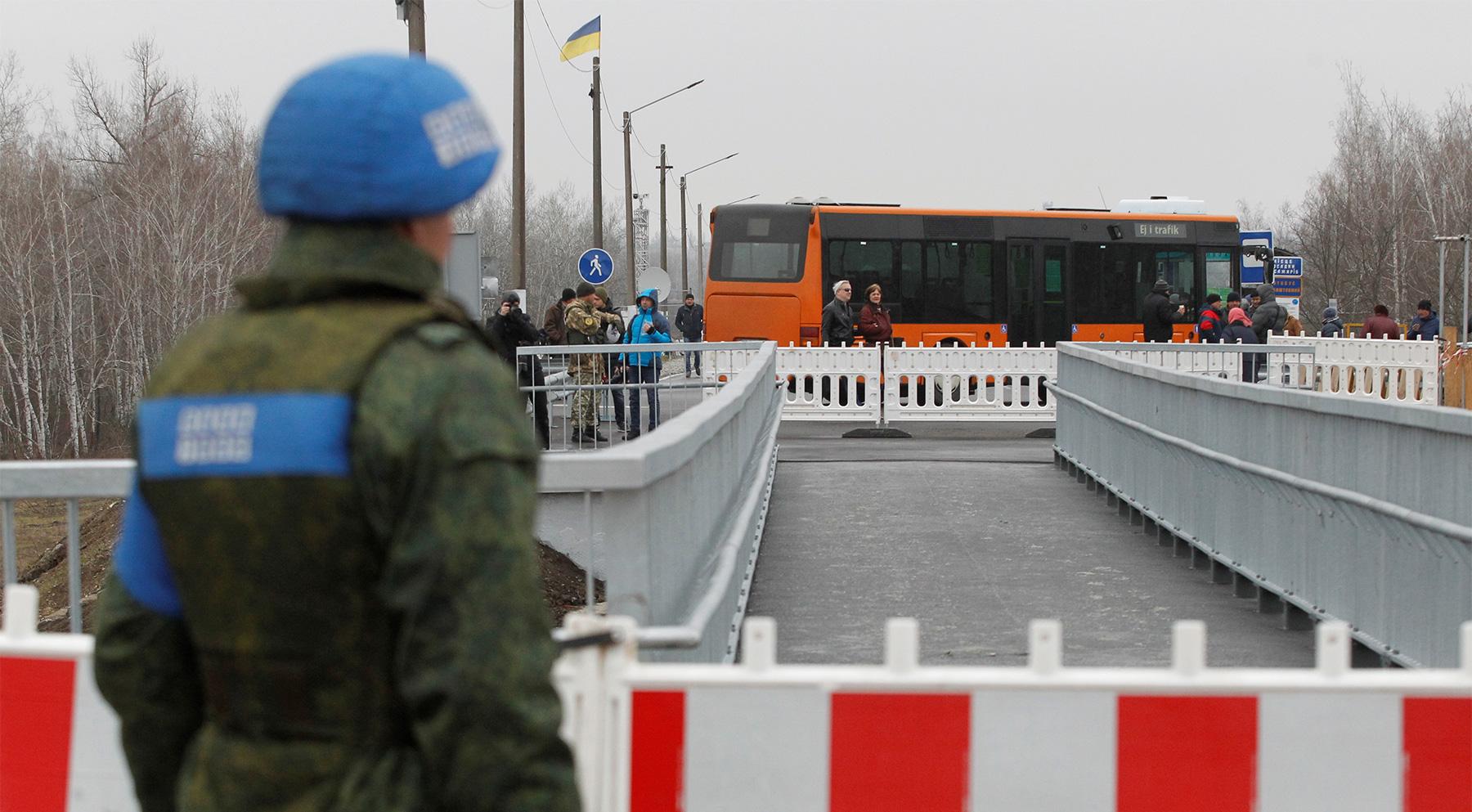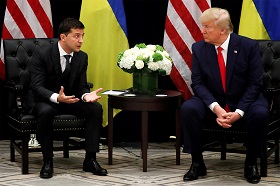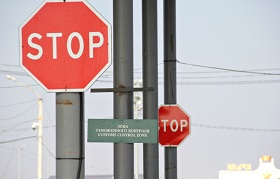Five years ago, in February 2015, the first steps towards a vision for peace in Ukraine were taken with the Minsk II agreement. Five years is a long time not only in human life, but also in European history: World War I only lasted four years, and World War II was only two years longer. Five years after Minsk, the crisis in and around Ukraine is yet to be resolved, and the country remains a bleeding wound of Europe with a profound negative impact on the overall relationship between the Russian Federation and the West. The tragic deaths of more than 12,000 people and more than 23,000 injured remind us of the human suffering in this conflict on all sides.
Many hoped that the Normandy summit in December 2019 would become a historic breakthrough, but the outcome of the meeting was quite modest. At best, the four leaders made a cautious step towards freezing the conflict rather than solving it. Protracted and painful discussions in Paris once again demonstrated that there is significant mutual resistance on both sides regarding a genuine settlement. Too many politicians in both Kiev and Moscow still believe that time is on their side, or, at least, that the risks associated with maintaining the current status quo in Donbass are lower than risks resulting from a status quo change.
In order to reach a breakthrough, we need to demonstrate enhanced creativity and out of the box thinking a la Albert Einstein, who observed, “Imagination is more important than knowledge...we can’t solve problems with the same kind of thinking we used when we created them.” One of the ways to ignite creativity is to look beyond the current crisis seeking mindset and adopt the positive crisis resolution experience accumulated in Europe.
Why South Tyrol?
European history knows many examples of how complex territorial, ethnic, confessional and other conflicts can last for many years and even decades without any clear prospects for a “final” solution. Take, for instance, the Armenian-Azeri dispute over Nagorno-Karabakh or the Serbia-Kosovo unfinished divorce. On the other hand, there are also success stories that we should not forget. One of the latter is the Alto Adige (South Tyrol) settlement of the dispute between Italy and Austria. This case, in our view, has certain similarities with the situation in East Ukraine.
South Tyrol was a bone of contention between the newborn Italian Republic and the Republic of Austria for decades. The conflict has never reached the scale of what we are witnessing today in East Ukraine, but it also generated violence, ethnic hatred and victimization. Moreover, it poisoned Austrian relations for a long time. After World War II, from the beginning of negotiations in 1947 until 1971, a series of agreements recognized equal rights for all citizens, despite their language, as well as a balanced decentralization of administrative, legislative, executive and economic competences to be exercised autonomously over the regional territory.
Historical and cultural bonds within the Austrian-Germanic world, Italy’s Trentino- Alto-Adige (South Tyrol) sought a highly autonomous status within the Italian Republic constitution. The process of deriving this status shows the value of reaching an agreement based on a high level of regional autonomy in political, economic, and cultural issues. This status received an appropriate codification within the Italian constitution. This approach eased the institutional balance between the centre and periphery, defusing, in the medium to long term, potentially disruptive political unrest.
South Tyrol successfully consolidated its autonomy over the last decades, fostering ties between the central state authority and the peripheral regional authority. Now, the German-speakers there live peacefully within Italy as citizens of the European Union.
This integration-through-decentralization process into the Italian national identity shows how a widely shared process and agreement recognizing a high level of institutional autonomy would lead, in the medium-to-long term perspective, to constructive and balanced power-sharing, stability and economic development. This achievement is particularly spectacular, given the long history of Austrian-Italian conflicts and even wars.
What Would It Mean for Donbass?
Italian Prime Minister Matteo Renzi had every reason to refer to the “South Tyrol model” at his meeting with President Vladimir Putin on March 5, 2015. The Russian leader welcomed it as a “valuable suggestion to resolve the situation”. After three hours of discussion in Moscow regarding the EU-Russia crisis involving Ukraine, Putin and Renzi gave a joint press-conference to review their discussion and proposals.
The Italian Prime Minister said, "I think it's worth highlighting the crucial step forward made," regarding the signature of the Minsk Agreement. "We will work to implement the statements of this Agreement. Europe and Italy can become a reference point." Italy in particular, according to the Prime Minister, might "provide all possible support for a solution concerning the urgent request of a new status and a wider autonomy to be granted to the Eastern Ukrainian Regions held by the separatists. We had a wonderful experience in Trentino-Alto Adige (South Tyrol). This is an excellent example of how you can successfully solve the problems of decentralization.”
“We agree that both the parties have to respect the Minsk II Agreement, paving the way to a peaceful solution,” stressed Russian President Putin. He added the need for a broader political dialogue involving the rebel strongholds of Donetsk and Luhansk as well. “We expect Italy, in its national capabilities and as a major European Union member, will play a key role in this process,” he argued. Putin told the media, “The Prime Minister made several valuable suggestions about what could be done to resolve the situation in the future. The situation there remains difficult, and we have to stop the fighting, killing and destroying cities.” The conflicting parties should strictly comply with the agreements reached in Minsk. “I count on more active help of the EU.”
If referred to within the context of the situation in Eastern Ukraine, many ingredients constituting the Austrian-Italian deal could help to settle the Donbass conflict, all the differences between the two cases notwithstanding.
The same rights extended to the local German population in Alto Adige (60 per cent in 1971) should be given to the predominantly Russian speaking (and Russia-oriented) locals in the Donbass. Rights similar to those preserved by Rome as the central government in Italy should be assigned to Kiev. Both languages should be granted official status, and no discrimination of any minority and cultures should be practised in Donbass.
Of course, this arrangement implies that the territory will be Ukrainian, including border-control. The Donbass should be de-militarized. That also applies to the Russian-Ukrainian border like it was the case with the Austrian-Italian border. The status of autonomy calls for guarantees embedded in the Ukrainian constitution, rather than merely a law, which could be changed at any time.
The South Tyrol experience also suggests that it would be impossible to solve and formulate all principal or small regulations for autonomy under Ukrainian law, as it adds up to several thousand details. Therefore, a smart framework agreement is needed and would lay the groundwork for ensuring the rights of ethnic Russians in the Donbass on the same level as those of ethnic Germans in South Tyrol. Such an agreement would also guarantee rights to Kiev similar to those of Rome. Leveraging this framework agreement as the model for Eastern Ukraine seems to be the only reliable way to handle the autonomy smoothly and avert further crisis.
The Austrian-Italian experience also suggests that there will be many bumps on the road to reconciliation and reintegration. To deal with these bumps, it would be helpful to establish a standing Donbass committee with ambassadors from each country within the OSCE in Vienna, with a special best practice team involving Austria and Italy. This committee could appoint an Ombudsman to handle complaints and resolve disputes. The Ukrainian government, together with the Donbass OSCE committee, should prepare an annual progress report and present it to the Verkhovna Rada.
What Is Missing?
Matteo Renzi came up with his proposal in March 2015. Unfortunately, not much has been done to apply the lesson of South Tyrol to Donbass. Therefore, the critical question is why implementing a strategy similar to South Tyrol in Donbass is not yet considered.
The answer, in our opinion, is in the international environment and the nature of the Austria-Italy relations. By the time of the South Tyrol deal, both Austria and Italy considered themselves organic parts of a greater European family of nations. This is despite the fact that Austria, even now, is not a NATO member and only joined the EU in 1995, 24 years after the agreement on South Tyrol had been reached.
Neither country had a fundamental identity problem that could feed radical nationalism and block a settlement. Their respective national identities emerged long before the deal was achieved. Neither side was fearful of aggression, deliberate provocation or gross interference into domestic affairs from the other side.
Both Vienna and Rome saw many advantages in building their economic, political and humanitarian ties with each other. Both Austria and Italy experienced rapid economic growth followed by an expanding middle class, vibrant civil society, maturing political institutions and successful fight against populism, political radicalism and nationalism. No external player in or outside of Europe demonstrated any interest in instigating the conflict through supporting one of the sides. In other words, the overall environment for reaching a compromise was overwhelmingly positive.
Unfortunately, most of these preconditions are currently absent in the case of Donbass. Therefore, we cannot push for the application of the South Tyrol model until such prerequisites are created. This will be difficult, but not impossible.
Going Beyond Minsk
Using the best practice from South Africa, one then is lead to think of a Truth and Reconciliation Commission for Donbas, reporting live on TV in Ukraine and Russia with an annual report. More than twenty countries have done this successfully in the past.
However, the problem of reconciliation is not limited to Donbass only. Both Russia and Ukraine today lack the know-how for true reconciliation, which had been mustered by Austria and Italy after World War II. Let us all learn from the American philosopher Eric Hoffer who said, “A war is only won after you have turned your enemy into a friend.” We can draw upon the lessons of other European states that have mastered the art of reconciliation, including decentralization, after two bitter world wars.
The governments, political parties, opinion leaders and media should learn how to make peace with (former) enemies and utilize European best practices – such as in South Tyrol or Northern Ireland. For the Russian population in Ukraine and all other minorities, including Hungarians and Tatars, fresh Ukrainian Codes of Tolerance should be implemented. The Kiev government should appoint a Minister for Tolerance and Reconciliation with sufficient staff and funding. The United Arab Emirates established the first minister for tolerance in February 2016. The tolerance minister in Kiev would promote respect toward all ethnic and religious minorities in Ukraine and report annually to the parliament and the OSCE in the form of a Ukrainian Codes of Tolerance and Reconciliation Report. Within the context of reconciliation, an amnesty committee would be established, as in South Africa, for people from all conflict parties.
Rebuilding trust will not get us too far until we build the economic foundations of the settlement. The goal should be to turn Donbass from a headache into an opportunity for all. We propose establishing a special reconciliation fund for the region, financed equally by the EU, the US, and the Russian Federation, and utilized to rebuild destroyed infrastructure. By rebuilding, we do not mean restoring the region as it was back in 2013 – this is hardly possible and rather undesirable. We suggest turning the devastated war area into a modern and vibrant ecosystem attractive to both international investors and millions of refugees and displaced persons.
Carefully designed and skillfully localized reforms can stimulate new jobs, especially for small businesses. It is essential to address burning issues of documented property ownership, competitive access to capital, legal enforcement of contracts, governmental and regulatory transparency, and rules that promote and safeguard foreign direct investment. The environment presents yet another challenge, but also another opportunity for multilateral cooperation in Donbass with the European Union taking upon a leadership role.
At the same time, the European Union should move in the direction of a free trade agreement with Russia and other members of the Eurasian Economic Union. A new Ostpolitik by Ursula von der Leyen could help to bring Europe closer together via trade and visa-free travelling.
Towards a New European Security Architecture
A new, fresh and intense dialogue between NATO and Russia, including the discussion of a non-aggression pact and new arms control agreements, is now needed. It was counterproductive to freeze the NATO-Russia Council in April 2014 as punishment. This forum, meant for crisis management, is now active again. It took too long to understand that we need more, not fewer, meetings during crises. Despite many state-banquets and vague speeches in the past years, real discussions were missing for far too long. The western “no-talk no-meetings approach” neglected the lessons learned in the months before World War I.
The dialogue about a common security structure in Europe should start with fresh bi-monthly meetings of the NATO-Russia Council in Moscow and Brussels, as well as in other NATO capitals. Russia and NATO should openly discuss all strategic military issues to find solutions to alleviate tensions and promote cooperation, with several working-groups established for major political, technological, or geographic regional concerns, including mutual threats.
A high-ranking NATO-Russia Summit should be held in Moscow to discuss security issues openly. At this summit, NATO and the Russian Federation should declare not to utilize their military capabilities against each other. They will not use their forces, equipment, active or non-active soldiers or allow those activities against each other.
Both Moscow and Kiev should find their rightful places in the new European security architecture. Confidence building measures between Russia and Ukraine should become a part of a broader CBM system between the East and the West of the continent.
In this new environment, we can broaden the limits of what is possible. All sides have to look for a creative compromise, based on respect for international law, recognizing the national interests and minority rights of all stakeholders, while drawing upon best practices in Europe.
The ultra-nationalists on both sides will be disappointed. Still, only a broad political compromise would be in the national interests of Ukraine, the Russian Federation, the EU, the United States of America and the international community.
We all need humanity, creativity and efficiency for a new Europe 3.0.










